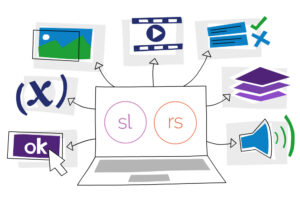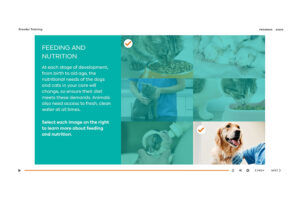
How to Use Animation in Rise 360 to Boost Engagement
Animation isn’t just for flashy intros or attention-grabbing transitions. When used with purpose, it can transform static content into memorable learning experiences. At B Online Learning, we’ve already shown how animation in Articulate Storyline can improve focus, guide attention, and simplify complex concepts. But what about Articulate Rise 360?
While Rise is known for its clean, responsive, and template-driven approach, you might be surprised at just how much animation you can bring in with a little creativity. In this post, we’ll explore both the built-in effects Rise already provides and the clever ways you can extend animation further with GIFs, Storyline blocks and even full-motion video created in Adobe Animate.
1. Built-In Animation in Rise
One of the reasons Rise courses feel so polished “out of the box” is because they already include subtle animations designed to support the learner experience. These may not be as bold or customisable as in Storyline, but they still add movement and polish in ways that help engagement.
Some key built-in animations include:
- Fade-in blocks – As learners scroll, blocks glide smoothly into view. This creates a sense of momentum and progression that keeps them moving forward.
- Interactive reveals – Blocks like click-and-reveals, flashcards, and accordions feature subtle motions when learners interact with them, guiding attention as new information appears.
- Progress indicators – The scrolling sidebar and progress bar animate as learners move through the lesson, giving continuous feedback and reinforcing a sense of achievement.
These animations are intentionally understated. They keep the interface modern and dynamic without distracting from the content.
2. Adding Animated GIFs
When you want to layer in more obvious animation, GIFs are the quickest and most accessible option. Any block in Rise that allows images will accept GIFs, which makes them incredibly versatile.
Practical ways to use GIFs in Rise include:
- Characters in motion – Add illustrated characters as GIFs with subtle movements (like blinking, waving, nodding, pointing) to bring important content to life.
- Highlighting changes – Imagine a chart that grows a bar up or a line that draws itself across the screen; a GIF can show progression far more clearly than text.
- Adding personality – For lighter topics, subtle GIFs (like moving icons) can bring warmth and human touch into your course.
- Software training – A looping GIF showing the exact clicks in a system is more effective than a static screenshot, while still lighter than embedding full video.
Since GIFs loop automatically, they can be engaging without requiring the learner to press play, making them ideal for micro-explanations.
3. Embedding Storyline Blocks
One of Rise’s greatest strengths is how it integrates with Storyline through the Storyline block. This allows you to inject Storyline’s full animation toolkit into a Rise course.
Use cases for Storyline blocks with animation include:
- Animated scenarios – A branching interaction enhanced with animated characters that visibly react, move, or change expression as the learner makes choices.
- Process simulations – Showing a workflow unfold step by step with motion paths or animated callouts.
- Interactive infographics – Graphics that build dynamically as learners click, turning a static diagram into a living explanation.
The combination of Rise’s sleek structure and Storyline’s powerful animation opens the door to blended design: learners enjoy consistent navigation with bursts of dynamic, motion-rich interactivity.
4. Animated Headers and Branding Elements
Headers set the tone for a lesson, and in Rise you can customise them with images. Why not make those images animated? Uploading an animated GIF as a header adds a dynamic touch right at the start.
Examples of animated headers in action:
- Compliance training – An animated “wave” graphic sliding across the top can soften otherwise serious content.
- Corporate branding – A looping animated logo reinforces identity in a subtle but professional way.
- Character-based courses – A friendly character waving or blinking at the start of each lesson makes the course more personable.
This type of animation is small, but it adds life to the course before a learner has even begun scrolling.
5. Using Full Videos for Animation
For maximum impact, you can embed fully animated videos directly into Rise. These can be uploaded to the course or streamed from platforms like Vimeo or YouTube.
At B Online Learning, we often create animations using Adobe Animate, supported by tools like Illustrator and Photoshop for graphics, and After Effects for extra polish. This combination lets us produce rich, custom animations that go far beyond what GIFs or block-level transitions can achieve.
Where animated video works best in Rise:
- Explainer videos – breaking down complex topics with visuals and voiceover.
- Storytelling sequences – characters and scenes that build context and empathy.
- Data visualisation – charts and graphics that move in sync with narration.
We often showcase this capability in our own work. Here’s our latest showreel as an example of how animation can elevate learning content.
6. Best Practices for Animation in Rise
With so many options available, it’s tempting to animate everything. But animation is most effective when it serves the learning, not when it overwhelms it. Keep these tips in mind:
- Be purposeful – Every animation should connect to a learning goal.
- Use sparingly – Too much motion can tire or distract learners.
- Optimise for performance – Compress videos to keep load times fast.
- Be consistent – Stick with one or two animation styles for a polished look.
- Test on mobile – Always check that animations work smoothly across devices.
When balanced well, animation boosts engagement without overshadowing content.
Final Thoughts
Animation in Rise 360 may not be as obvious or customisable as in Storyline, but the opportunities are richer than many people realise. From the fade-in blocks that come standard, to creative use of GIFs, Storyline blocks, animated headers and full animated videos from Adobe Animate, Rise can be transformed into a lively, engaging learning environment.
When animation is purposeful, learners connect, interact, and retain knowledge more effectively. By blending Rise’s sleek design with the right animation techniques, you can deliver courses that are not only professional and responsive but also memorable.
At B Online Learning, we believe animation is one of the most powerful tools available to today’s designers. Whether subtle or bold, the right movement makes learning stick. Get in touch if ou need help adding animation to your eLearning courses.
Source link



